To be honest: I have also gone through 6 liquidation events, losing over 8 million in three nights, with all my principal reduced to just the remaining battery on my phone.
In pain and reflection, I found that 90% of explosive profits are hidden in two extreme emotions - extreme panic and extreme greed. Below, I will break down 5 actions that save lives and make money.

1. Position: Divide 3000 into 3 parts, each part 1000.
Don't think about doubling yet; first, think about how not to die.
2. Leverage: 10 to 20 times is the sweet spot, any higher and you are working for the exchange.
3. Take profit: After gaining 100%, withdraw the principal first, and the remaining profit is considered 'cost-free bullets'.
4. Stop-loss: If you lose 30% of your principal, cut it immediately. If you delay, it won't help even if you bruise your thigh.
5. Reinvestment: Earned 12,000 for the first time, took 6,000 to continue rolling, and locked the rest in a cold wallet.
When to pull the trigger? Remember that three signals must be on at the same time:
BTC daily drop ≥15%, on-chain liquidation volume hits a new high for 7 days.
Funding rates have been negative for 12 consecutive hours, and shorts are squeezed like canned goods.
4h RSI <30, but don’t rush to catch the bottom; wait for a bullish candle to confirm.
On October 11, 2023, ETH reached a low of 1520. All three signals lit up, and I entered the market:
Initial position 2000U, 20x leverage, stop-loss at 1480.
Rebounding 1600 to withdraw the principal, with profits of 2000U continuing to roll.
Secondary position increase of 2000U, rising to 1780, with profits changing to 8000U.
After confirming the trend for the third time, I bet all 8000U, pushing ETH to 2100, with the account's net value just over 100,000U.
The key is the last step: judging whether the trend has truly started.
I use the 'volume-price divergence + funding rate reversal' combination - when the price breaks the previous low, while OBV has not broken, and the funding rate flips from negative to positive in a second, that is the shout of a short surrender. This combination has a win rate of 65% and a risk-reward ratio of 5:1, enough for me to use for a year.
Do not mythologize luck; it is rhythm + strategy + execution.
The market always has opportunities, but most people only know how to chase highs and kill lows. First, learn to survive, then learn to roll positions.

This content is based on years of trading experience, focusing on achieving steady profits through 'strict adherence to rules, restraining greed'. Key methods and suggestions can be summarized as follows:
I. Core operational principles
Signal priority: Only operate when 'familiar signals' appear; it’s better to miss the opportunity than to make impulsive decisions.
Refuse to gamble: Deny the obsession with 'greed for rebounds and greed for recouping losses', emphasize the importance of stop-loss, and point out that 'the persistence of not wanting to stop-loss is not a belief, but gambling.'
II. 7 practical suggestions (with key details)
1. Time selection:
Make trades after 9 PM. Daytime news is chaotic and misleading, while evening news is stable, and candlesticks are clear, reducing misjudgments.
2. Take profits:
Withdraw a portion of funds immediately after making a profit. For example, when earning 1000U, withdraw 300U to a bank card to avoid giving back profits in pursuit of higher returns.
3. Indicator references:
Rely on three indicators from TradingView for judgment; at least two signals must be consistent to enter the market, do not operate based on feelings.
MACD: Observe whether a golden cross or death cross appears.
RSI: Determine whether in an overbought or oversold state.
Bollinger Bands: Pay attention to whether they are contracting or breaking out.
4. Flexible stop-loss:
When you can monitor the market: After making a profit, manually move the stop-loss price up (e.g., buying at 1000, if it rises to 1100 then move the stop-loss to 1050) to lock in profits.
When unable to monitor the market: Set a 3% hard stop-loss to prevent sudden market movements from causing significant losses.
5. Regular withdrawals:
Withdraw 30% of profits to the bank card every week to avoid account funds being just 'numbers' and to accumulate real profits over time.
6. Candlestick techniques:
Short-term operations: Look at the 1-hour chart; if the price has two consecutive bullish candles, consider going long.
In a sideways market: Switch to the 4-hour chart to find support lines, and enter the market when it falls near the support level.
7. Pitfall reminder:
Leverage control: No more than 10 times, beginners are advised to stay within 5 times.
Coin selection: Avoid Dogecoin, shitcoins, and other altcoins to prevent being harvested.
Order quantity: A maximum of 3 orders per day to prevent excessive operations from getting out of control.
Source of funds: Never borrow money to trade cryptocurrencies.
III. Summary of core views.
The key to making profits in cryptocurrency trading is to 'lose less and gain more,' rather than pursuing high returns; giving up illusions and admitting mistakes is more important than stubbornly holding on. There is no 100% profit in the B circle.
A price action chart refines your correct cryptocurrency trading: stop blindly chasing candlestick signals! Build a high-win-rate price action trading system in 5 steps.
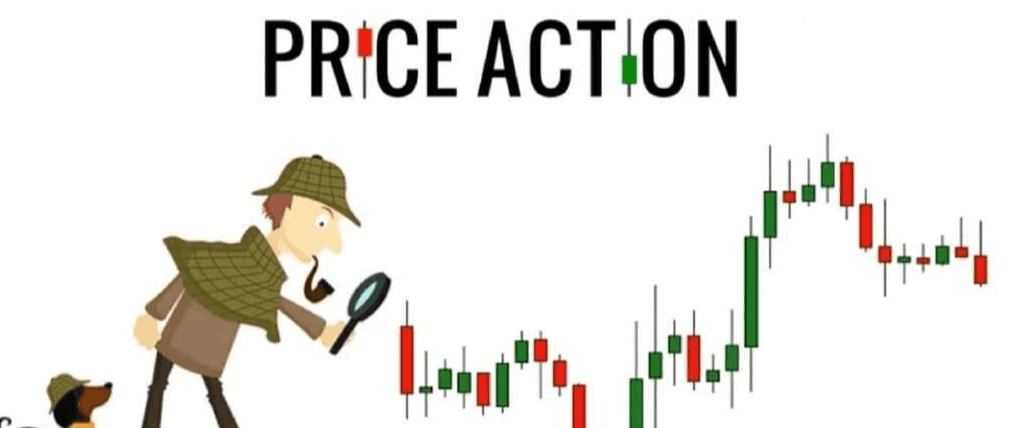 A price action pattern or 'signal' is not just waiting for a candlestick pattern you like to appear and then blindly placing an order.
A price action pattern or 'signal' is not just waiting for a candlestick pattern you like to appear and then blindly placing an order.
An effective signal should be a multi-step decision process that integrates all factors to form a reasonable trading idea.
You can view it as a qualification review process - we first analyze the market environment, identify the key areas that should be traded, and then wait for signals to appear.
Step #1: Conduct technical analysis to confirm an effective market structure.
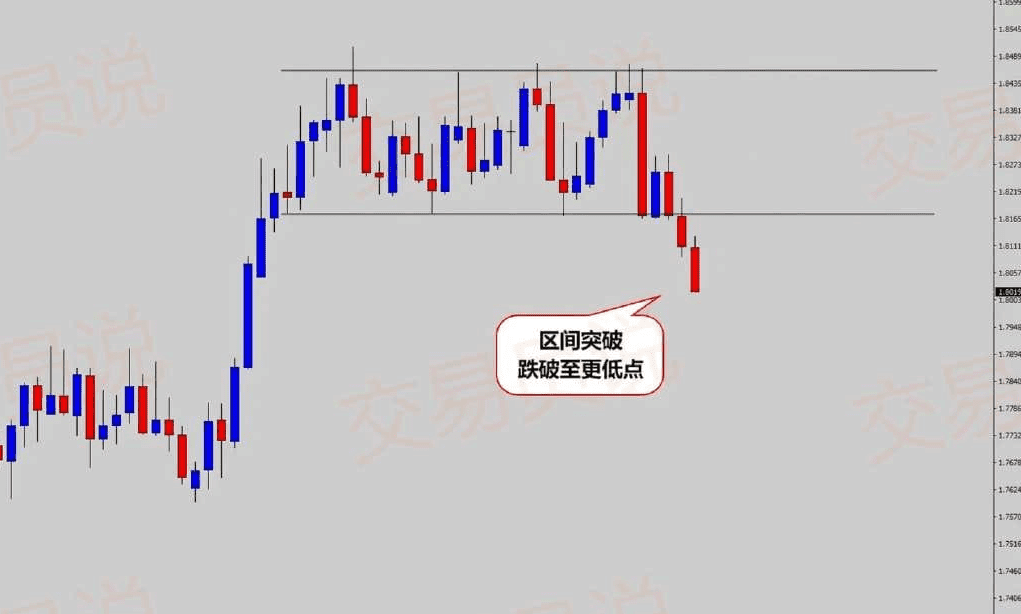
This step is crucial. Do we have the trading conditions? What is the market structure like?
Without a reasonable market background and structure, we cannot continue trading.
This example shows an interval market that recently broke below the lower bound of the interval. Our ideal operation is to look for bearish signals to follow the trend.
Step #2: Identify the location where you expect trading signals to appear.
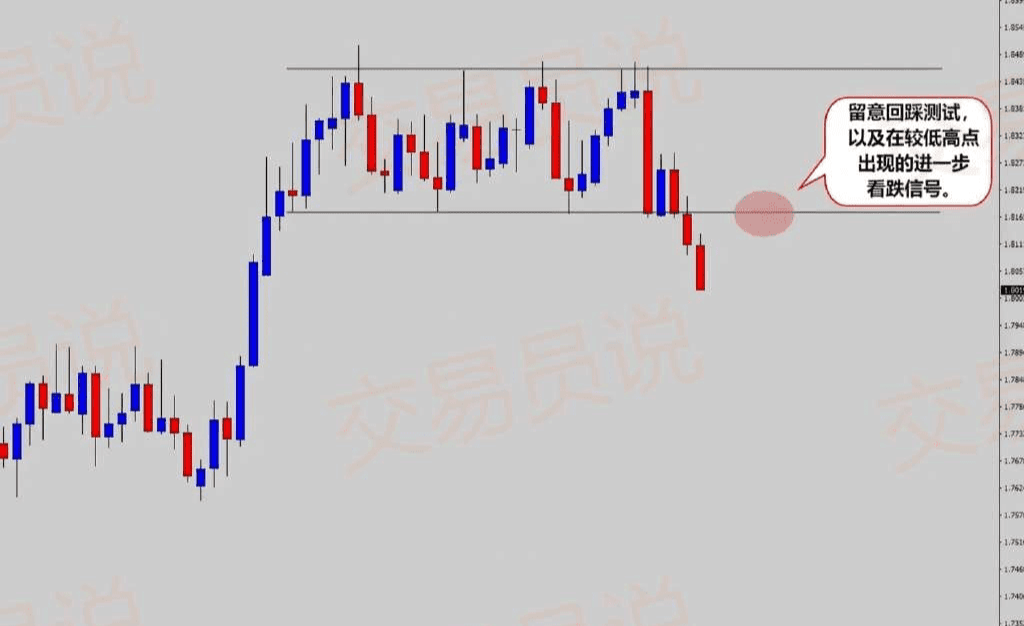
Once a directional preference is established, we return to technical analysis to mark the locations where price action signals are most likely to occur.
Step #3: Wait for the expected signal to appear.
If a signal (such as a certain candlestick pattern) appears at (or near) the predicted location, this is a very compelling basis for entering the market.
Step #4: Check the profit potential of the trade - focus on the resistance levels of price trends.
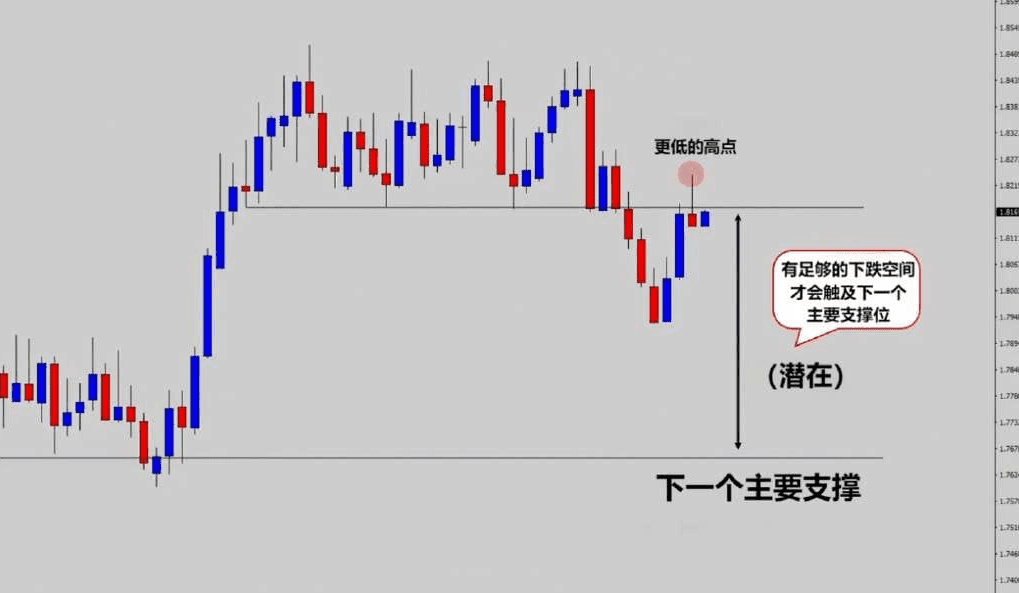 Ensure that the potential profits from the trade far exceed your risk exposure. Confirm that there is enough profit space (the price has enough room to run) until the next important structural point.
Ensure that the potential profits from the trade far exceed your risk exposure. Confirm that there is enough profit space (the price has enough room to run) until the next important structural point.
Step #5: Place orders, let go, and reap - a relaxed strategy for forex traders.
Once the trade is evaluated, set the entry, stop-loss, and target price.
The best practice is to let trades run naturally until they hit the stop-loss or target price. The less human intervention, the better the result!
This is the method for filtering out invalid signals. If any step in the process fails, this trade is likely not worth making.
Only when all conditions are met can you form a high-probability trading pattern that you can trust.
The value and logic of trading come from:
Start with the basics, keep the thought process simple and logical, follow the market structure, and maintain patience.
Lesser-known charts that are rarely mentioned.
There are many chart formats available in the market, far beyond the classic candlestick chart (although most people are most familiar with it). Price action traders can utilize these different chart forms to observe the market from various angles.
These other price action charts can actually help you discover opportunities that are difficult to detect with traditional candlestick charts.
This is an area I am currently researching in-depth, and the preliminary results look very promising.
Now, let’s first look at the classic candlestick chart and compare it with some other available chart formats.
Customized candlestick charts display unique price movements.
Most traders believe that the New York session closing chart is the only chart worth paying attention to, but the fact is, the New York closing chart only provides a reference point for analysis.
I’m not saying the New York closing chart is bad; it’s excellent, and I use it every day. But have you considered using the London opening time as a reference point for cross-analysis?
Let’s compare the New York closing chart and the London opening chart…

Through the London session opening chart, we can identify a strong sell signal, while this signal is not as obvious on the New York closing chart.
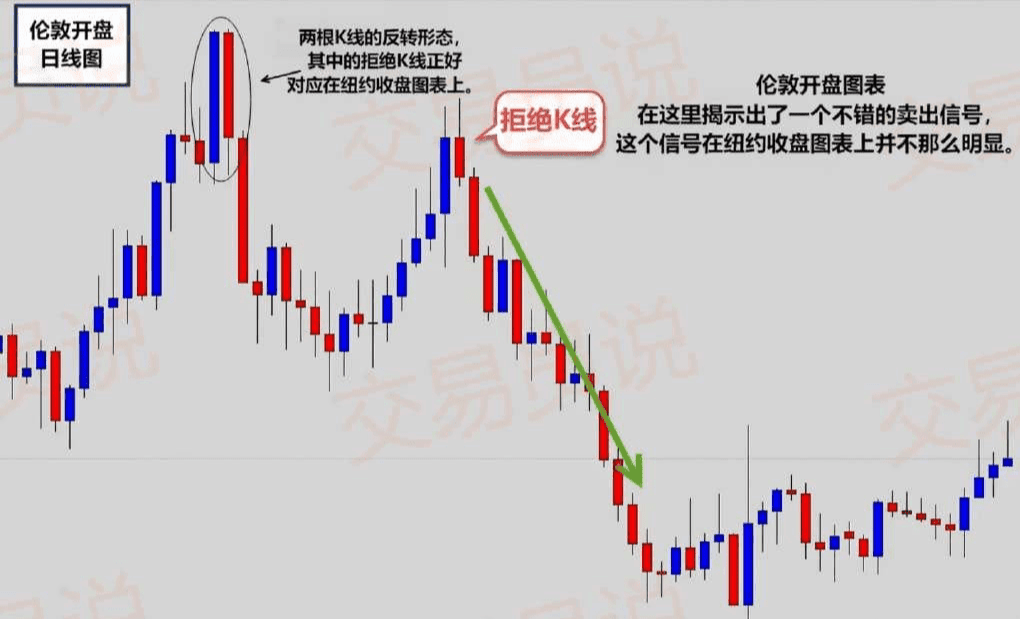
However, this does not mean that the New York closing chart lacks value; we can also see a clear large sell signal on the New York closing chart, which is not obvious on the London opening chart.
Also attach a New York opening chart for reference…
There are no particularly obvious signals here, but this just indicates that on the same currency pair, we can have three different time perspectives, greatly altering the chart's presentation.
This is the so-called 'gold panning' strategy, filtering through different time perspectives to find price behavior 'gold mines' that others have not discovered.
You can actually adjust the chart time in 23 different ways, or even generate charts for every hour in Greenwich Mean Time (GMT), but I think it’s more reasonable to keep it simple and focus on 'critical moments', such as the New York closing, London opening, and New York opening.
This opens the door to unique analysis for price action traders!
Summary
Price action trading is not operated in isolation based solely on a single variable but considers the market environment, price structure, expected signal location, and profit potential comprehensively.
Additionally, by adjusting the opening and closing times of the candlesticks, we can obtain different versions of candlestick charts. By switching the time perspective to key market moments (like the London opening), we are able to 'see' patterns that are not easily noticed on standard charts.

Money management techniques for funds of 50,000 to 500,000 dollars: Retail investors must get four reductions right.
Three tips to accurately grasp the timing of buying and selling Bitcoin.
I once met a senior who has been deeply involved in the cryptocurrency market for many years. He entered the market with 100,000 funds in the early years, and now his account assets have reached tens of millions. One of his remarks enlightened me: 'The essence of the cryptocurrency market is an amusement park of emotions; most people are just blind tourists following the crowd. If you can control your own temperament, this place is a treasure.' According to him, the key to truly profiting in the cryptocurrency market lies in the following points:
First, do not be greedy for small profits, and do not take big risks.
These eight words seem simple, yet they stump 80% of people. For example, you open a long position at 20,000 and quickly take profits at 21,000 for a 5% profit, only to miss the subsequent rise to 25,000. Next time you 'behave' and wait for the price to pull back to 20,000 to open a long position again, but when it rises to 21,000, you hold on, only for it to drop back to 19,500 and have to cut losses. Many people repeatedly fall into this vicious cycle, unable to break through.
Secondly, focus on mainstream coins that have experienced a significant drop and are stabilizing.
Do not chase flashy new coins but choose mainstream coins that stabilize after a deep drop. Start with a 10% position to test the bottom, without subjectively guessing the lowest point, and take action once the trend is clear. This method may seem clumsy, but it is indeed stable.
Thirdly, increase positions after a clear trend correction.
Do not be obsessed with catching the lowest point; you can wait for the trend to establish and then add positions in batches during the pullback of 20%-30%. Although the cost is slightly higher, it is far better than being stuck halfway up the mountain.
Fourth, take profits in batches for safety.
After each wave of rise, first recover the principal and part of the profits, leaving the remaining positions for market fluctuations. Once the preset target is reached, decisively exit, do not be greedy and linger. Only what is truly put into your pocket is the money earned.
Last year, he used this method to help a friend who lost over 600,000 to not only break even in half a year but also earn an additional family car.
The cryptocurrency market is never short of smart people; what it lacks are 'pragmatists' who can restrain their impulses and maintain patience. While everyone else is busy chasing highs and killing lows, you only need to follow the trend steadily to pick up the chips others have hurriedly discarded.
The wisdom of top traders.
Qi Baishi once said: 'Those who learn from me live, those who imitate me die.' This master artist from a carpenter background expressed a universally significant philosophical truth, which also applies to the investment market. No trader can accurately predict the market; the market will not consider anyone's emotions and expectations.
The most important thing in trading is not predicting the market direction but following the trend. The fluctuations during the process test one’s will and are also an inevitable cost of trading. How to identify and follow the trend depends on personal cultivation. Successful traders all have a system that suits them and execute it strictly according to rules. In fact, in this volatile market, the only thing we can control is ourselves. This also explains why professionals may not have much of an advantage in the trading field. Human nature has inherent strengths and weaknesses; mastering these traits is a lifelong challenge for investors.
Market sense is also an important element of advantage. Although a lot of homework needs to be done before trading, many successful traders still rely on certain principles and intuition during actual operations, which is called market sense. Good market sense requires accumulation and a gradual process.
Self-understanding and validation is a challenging and arduous path. All technical analysis, including Gann theory and wave theory, is used to predict market trends. These theories seem perfect but are very difficult to apply. 'One does not have to rely solely on books to do things; one cannot be without books to be a person.' Studying classic works helps broaden horizons and improve trading systems.
The so-called thoughts, concepts, and philosophies serve two purposes: one is the realm of great traders, and the second is the packaging of quotes by critics. Ordinary people who wish to become successful traders should focus on the following three things and strive to achieve them to the utmost:
When is the timing for opening a position?
What to do if the market is unfavorable after opening a position?
What to do if the market is favorable after opening a position.
Einstein divided wisdom into five levels: cleverness, wisdom, excellence, genius, and simplicity.
Cleverness refers to a smart mind; wisdom refers to reasonable actions; excellence refers to outstanding methods; genius refers to the incomparable; simplicity represents a deep understanding and strong execution in a specific field. Not only is genius hard to comprehend, but 'simplicity' is also not easy to read. Knowing and acting is an ancient proposition. Many seemingly simple principles are rarely practiced.
Making simplicity extreme is success. Therefore, the market generally believes that mature traders will ultimately return to the simplest and most original techniques.
Ironclad rule in cryptocurrency trading: grasp the trend, control the risk.
Seek quality, not quantity: Focus on 1 variety with 50,000-80,000 funds, a maximum of 2 with 180,000-300,000, and no more than 4 with over 500,000;
Hold positions should be simplified: Do not hold more than 3-4 positions at the same time, and prioritize handling breaking positions when at a loss.
Follow the trend: If the daily line is above the 200 moving average, look bullish; if below, look bearish, do not operate against the trend.
Grasp the timing rules: Asian session's sharp drops are not alarming; European session is prone to rebounds; after a big surge in the US session, the next day often sees a correction.
Active session trading: Focus on the European session (14:00-20:00) and US session (20:00-24:00), avoiding the quiet hours of the early morning.
Strength and weakness identification: Coins that resist declines during a market crash are often strong and should be focused on.
Strict stop-loss and take-profit: never lower the stop-loss for losses, take profits in batches when in profit.
Moving averages as a basis: Look at the 5-day moving average for short-term, the 20-day moving average for mid-term; the simpler the method, the more effective it is.
Decisively execute: Act immediately when conditions are met, without mixing emotions.
Add positions on profits, do not top up on losses: Only add to profitable positions, never average down on losing ones.
Investing should be as natural as breathing. The cryptocurrency market cannot be predicted; it can only explore trends based on historical data and market psychology. Buffett emphasizes investing in familiar products, which is against blindly following trends. When in a crowd, individual awareness is easily influenced by the group, leading to a deviation from reality. In the cryptocurrency market, intelligence, hard work, experience, and luck are all indispensable. Luck often favors the diligent rather than the smartest.
Only by relaxing your mindset and remaining calm, investing as naturally as breathing, can you become a winner in the cryptocurrency market.
No matter how diligent a fisherman is, he will not go out to sea in stormy weather but patiently guards his fishing boat, waiting for sunny days. The door to the cryptocurrency market is always open; following the trend is the only way to have a smooth life.
Wen Jing focuses on Ethereum contract spot ambush; the team still has positions to board #稳定币监管风暴 $ETH.


